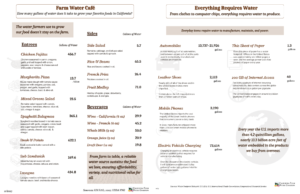UPDATED 5-29-15
Assembly Member Rudy Salas (D-Bakersfield) has introduced AB 1201, a legislative bill that would require the California Department of Fish and Wildlife to develop and initiate a science-based approach that helps address predation by non-native species on Delta species. According to analysis prepared by Assembly Water, Parks and Wildlife Committee staff, the bill would accomplish two primary goals:
1) Makes findings related to the decline of native fish species in the Sacramento-San Joaquin Delta (Delta) and the potential for predation by nonnative species on those at-risk fish species.
2) Requires DFW, by June 30, 2016 to initiate a science-based approach that helps address predation by non-native species upon species in the Delta listed as threatened and endangered under the California Endangered Species Act (CESA).
A list of supports and opponents as of 5-29-15 is available here.
Fish eat fish.
(Originally published January 20, 2015)
In the Seinfeld episode, “The Watch,” Jerry Seinfeld says to a woman in a restaurant, “You know why fish are so thin? They eat fish.”
Despite their diets all fish aren’t thin. Take bass, for instance. They eat fish. They eat a lot of fish. Bass in California’s Sacramento-San Joaquin Delta eat a lot of baby salmon and dining season is coming up fast. You see bass, according to the California Department of Fish and Wildlife, will begin to increase their fish consumption in the next few months.
Bass eat endangered salmon

According to “Striped Bass Fishing Tips” on the California Department of Fish and Wildlife website, spring is when bass – an invasive species introduced to provide recreational fishing in the Delta — start their annual feeding frenzy on native salmon.
During the winter, striped bass are spread from San Francisco Bay throughout the Delta and fishing is generally poor because stripers do not feed actively when the water is cold. Fishing success improves as the water warms up in March. Stripers that winter in the bays start moving upstream to fresh water for spawning. During the spring, the bulk of the legal population is spread throughout the Delta and as far north as Colusa and Princeton on the Sacramento River.” http://goo.gl/fzr9ex
Federal government cuts water supply to farms
On January 1 the federal National Marine Fisheries Service (NMFS) instituted a management action that reduced water deliveries to 25 million Californians and millions of acres of farmland in the name of protecting salmon. In its December 30, 2014 announcement, NMFS justified its decision by saying the bulk of the migrating salmon move into the Delta by the end of December. Reducing export pumping at that time, according to NMFS, “…would protect a sizeable proportion of the winter-run (salmon) population that has already entered the Delta region.”
Then the very next sentence in the announcement says, “These fish will distribute themselves within the Delta and are expected to rear for up to 3-4 months before continuing their emigration to the marine environment.”
That is if they survive the journey.
During these months, bass increase their fish consumption at the same time baby salmon are rearing in the Delta, growing in size in preparation for the remainder of their migration to the ocean. Good luck, baby salmon! You’re likely to become a meal.
Salmon slaughter
The March 2009 issue of Western Outdoors Magazine article titled “Save a Salmon, Catch a Striper” says it all:
“You see, the peak of the baby salmon’s downstream journey corresponds with the spring spawning run of striped bass. Somewhere along the line, the two migrations crash headlong into one another. It’s a one-sided blood bath, and when the spray and foam settles, the stripers emerge fat and happy while the Chinook suffer heavy loses.” https://farmwater.org/salmonslaughter.pdf
A 2010 article by Alistair Bland in the East Bay Express titled, “The baby salmon feeding frenzy in San Pablo Bay” pointed out that bass fishing party boats target areas where hatchery salmon smolts are released into the bay because the fishing is so good.
Bass fishermen can get their limits in “just minutes” and when the bass are cleaned and filleted their stomachs often contain from one to six salmon smolts. http://goo.gl/vWnAn1
What, if anything, is NMFS doing to protect salmon from predatory bass at the same time that it ratchets down export pumping? Twenty years of data show that pumping has had no long-term impact on salmon populations. However, a federal study released in 2013 demonstrated that 93 percent of juvenile salmon on the Tuolumne River are consumed by predators while attempting to migrate to the ocean. http://goo.gl/p0zeA
What is the logic in not addressing that? Where is the outrage from the commercial salmon industry?
The real problem gets ignored
Why are other stakeholders and regulators willing to accept the status quo and reject real reform that will restore the Delta to its former productive salmon fishery? At the same time a handful of bait shops profit from the salmon-gobbling bass industry. ESPN and others broadcast high-dollar bass tournaments. And bass fishing advocates continually say that it’s the farmers of the San Joaquin Valley that are destroying the Delta.
Fishy.




